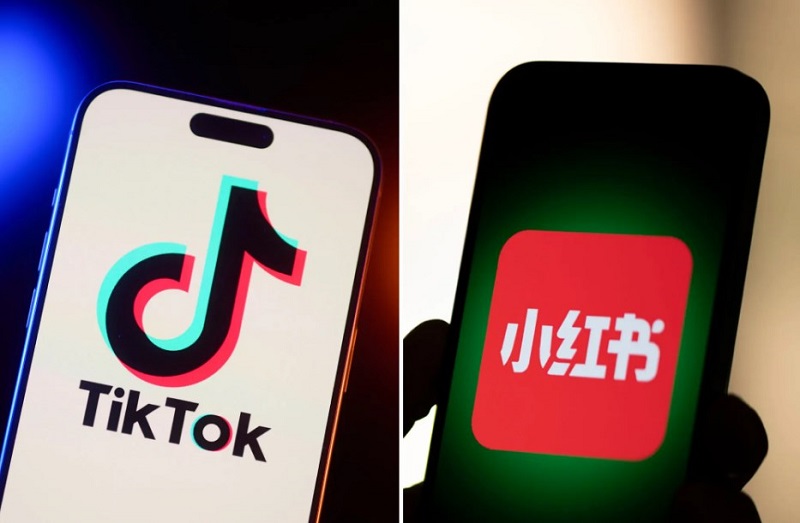As the U.S. considers banning TikTok, young Americans are turning to Xiaohongshu, dubbed “China’s Instagram,” for a familiar social media experience.
While users embrace the platform, they face cultural differences and censorship rules, sparking a blend of excitement and caution.
Experts doubt the shift will last but see implications for Big Tech.
Content Highlights
- TikTok Ban Impact: Surge of U.S. users on Xiaohongshu, a Chinese social media app.
- Platform Overview: Xiaohongshu offers Instagram-like features and focuses on lifestyle and shopping.
- Cultural Shift: American users face Chinese app rules, including censorship of sensitive topics.
- Monetization Challenges: Xiaohongshu’s revenue model differs from TikTok, complicating transitions for creators.
- Industry Insight: Experts suggest the migration highlights stagnation in U.S. tech products.

As the potential TikTok ban in the United States looms, many American users are migrating to Xiaohongshu, a Chinese social media platform, in search of a similar experience.
Xiaohongshu, often referred to as China’s answer to Instagram, has surged in popularity, rising to the top of the iOS and Google Play stores in recent days.
With TikTok’s future uncertain, this wave of American users, some calling themselves “TikTok refugees,” is reshaping the landscape of social media.
A New Beginning on Xiaohongshu
Xiaohongshu, known for its lifestyle content and female-centric user base, has welcomed the influx of American users with open arms.
The app, which boasts approximately 300 million monthly active users, is often compared to Instagram for its emphasis on photos, videos, and personal expression.
While smaller than other Chinese giants like Sina Weibo and WeChat, Xiaohongshu’s growth has been meteoric as users prepare for the worst-case scenario regarding TikTok.
One user, “Star404,” shared her excitement about the app’s new American community: “We’re going to do so great.
This is so much better than TikTok. Just not Meta,” she said in a short video, garnering thousands of supportive comments from Chinese users.
The platform’s “Discover” page is now brimming with tips on how to navigate this new social media space, affectionately renamed “RedNote” by American users.
A Cultural Crossroad: Chinese and American Users Unite
The irony of Americans leaving one Chinese-owned app only to flock to another is not lost on observers.
“It’s definitely funny that American teenagers are protesting the looming TikTok ban by using a much more culturally Chinese app,” said Ryan Broderick, author of Garbage Day.
The migration to Xiaohongshu is creating a cultural blend never seen on TikTok, where East and West converge in a unique online experience.
The excitement around this new platform is palpable, with some American users expressing their gratitude for the warm reception.
“Thank you so much for all the support, I really appreciate it,” said “Fern,” a user who gained 50,000 new followers within 24 hours of joining the platform.
This swift integration into the Xiaohongshu community marks a bold new chapter for social media users on both sides of the globe.
Xiaohongshu Faces Growing Pains
However, the sudden surge of American users has left Xiaohongshu’s parent company in a precarious position.
Chinese media outlet PConline reported that Xiaohongshu employees have been instructed not to discuss or promote the new influx of U.S. users.
These unexpected visitors are both a blessing and a potential source of risk, especially given the regulatory challenges that may arise from the app’s growing international presence.
China’s strict internet censorship laws are another hurdle.
Social media platforms in China require users to register with a Chinese phone number, and content is subject to heavy government regulation.
As a result, Chinese companies often create separate versions of their apps for international users, as seen with TikTok and Lemon8.
While American and Chinese users are currently seeing the same content on Xiaohongshu, the app’s rules remind everyone to steer clear of sensitive topics such as politics and religion.
A Shift in Content Creation and Monetization
For American content creators, the transition to Xiaohongshu may not be as seamless as expected.
Unlike TikTok, where creators often monetize through sponsorships and affiliate links, Xiaohongshu leans heavily into e-commerce, with live-stream shopping gaining significant traction.
This shift in monetization models presents a challenge for creators used to TikTok’s system, which allows them to earn income through a more flexible structure.
Yet, some experts believe this cultural shift could spark meaningful change in the American social media landscape.
“It’s a funny way to hopefully make U.S. politicians realize that Chinese apps are coming for the U.S. whether they like it or not,” Broderick said, highlighting how platforms like Xiaohongshu could shake up Big Tech in the long run.
The Future of Social Media: Bridging Cultures
While the future of TikTok remains uncertain, the migration of American users to Xiaohongshu serves as a powerful reminder of the global influence of Chinese tech.
Despite the cultural and regulatory challenges that lie ahead, this new wave of social media exploration offers a glimpse into a world where East and West blend together on digital platforms.
As American users continue to explore Xiaohongshu, the community will undoubtedly grow, creating new cultural exchanges and digital experiences that transcend borders.
It remains to be seen whether this migration will be a passing trend or a sign of a deeper, lasting shift in the world of social media.